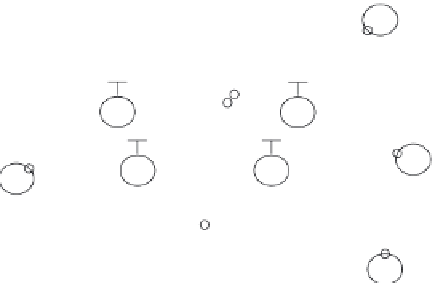Geoscience Reference
In-Depth Information
Water retention rate (
R
wat
)
Lake water
M
W
Inflow (
Q
.
C
in
)
Outflow (
Q
.
C
=
M
.
R
wat
)
Sedimentation
rate (
R
sed
)
Internal
loading
(
M
S
.
R
res
)
Sedimentation
(
M
W
.
R
sed
)
Internal loading
rate (
R
res
)
M
S
Lake sediments
Particulate fraction (
PF
)
V
.
d
C
/d
t
Q
.
C
in
Q
.
C
M
W
.
R
sed
.
PF
M
S
.
R
res
=
−
−
+
d
C
/d
t
=
change in concentration in lake water
C
=
M
W
/
V
;
V
=
lake volume
Fig. 4.12
The basic mass-balance equation for a lake
with internal loading.
T
w
=
V
/
Q
;
Q
=
water discharge
C
in
=
tributary concentration
conditions, because the sediment concentrations
of these substances mainly reflect sediment redox-
conditions and low redox values may appear
in sediments of most lakes. On the other hand,
sediment Ca concentrations more closely reflect
typical lake properties on a scale from low to
high calcareous conditions.
0
=
Q
·
C
in
−
Q
·
C
−
M
W
·
R
sed
·
PF
+
M
S
·
R
res
(in)
(out)(sedimentation)(resuspension)
where
V
is the lake volume (usually m
3
or km
3
),
C
is the concentration of the substance in the
lake water (units usually g L
−1
or kg m
−3
;
C
is the
M
W
/
V
),
C
in
is the concentration of the
substance in the tributary (
C
in
has the same
dimension as
C
),
Q
is the tributary water dis-
charge to the lake (usually expressed as m
3
yr
−1
or m
3
month
−1
),
R
sed
is the sedimentation rate
of a given substance in the lake (like all rates,
R
sed
has the dimension 1/time and its unit is usu-
ally 1/day, 1/month or 1/year),
M
W
is the mass
(
4.2.4 Mass-balance modelling for lakes
The basic aim of mass-balance calculations is
to quantify fluxes so that large and important
fluxes may be identified and differentiated from
small fluxes. The aim of this section, however, is
not to give a full mathematical account of all the
processes shown in Fig. 4.2, only to give a brief
introduction to mass-balance modelling and to
illustrate some basic concepts with a focus on
sedimentation in lakes.
A simple mass-balance model for a lake is
depicted in Fig. 4.12. A typical mass-balance
model envisions the lake as a 'tank reactor' in
the sense that the lake mixes completely during
an interval of time d
t
. The flow of suspended
particulate matter (or a given contaminant) to
and from such a lake, and net sedimentation may
be described by the following equation (this is
the steady-state solution to the equation given
in Fig. 4.12):
amount) of the substance in the lake water
(units often in g or kg),
PF
is the particulate
fraction (dimensionless), the only fraction that
can settle out in lakes due to the influence of
gravitation,
M
S
=
amount) of the
substance on the lake bed (units in g or kg),
R
res
is the internal loading rate, or resuspension rate
(units usually in 1/day, 1/month or 1/year). The
steady-state assumption means that a change in
lake concentration (d
C
) of the given substance
per unit of time (d
t
; usually in g L
−1
month
−1
or
kg m
−3
yr
−1
) is set to zero.
The lake water retention time (
T
, in days,
months or years) is a fundamental concept in
lake studies. It is defined as the ratio between the
is the mass (
=
























